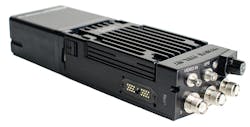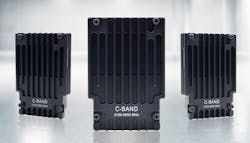Download this article in PDF format.
Unlicensed communications in industrial-scientific-medical (ISM) frequency bands have long been of interest to defense/military users as a way to add bandwidth when and where needed for particular applications. The latest frequency modules for the MPU5 mobile ad hoc networking (MANET) “smart” radios from Persistent Systems, LLC transform those radios into powerful, portable radios for use at upper C-band frequencies from 5.1 to 5.9 GHz within the unlicensed ISM band. This opens the door not only to defense contractors, but portable radio specifiers of all kinds to consider their needs for reliable voice, text, video, and data communications with these robust modular radios.
1. The modular MPU5 radios work with additional plug-in frequency modules to cover different frequency bands from L-band through upper-C-band frequencies.
The Wave Relay MPU5 radios (Fig. 1) are as much computers as portable radios, each powered by an Android operating system. Like computers, the radios enable connection of external USB devices; the radios also have enough computer background to form and create self-healing networks with other radios and computer devices. The latest radio modules (Fig. 2) operate from 5.1 to 6.0 GHz with three independent antenna chains, each contributing more than 1.3 W transmit power to total 4 W transmit power.
The frequency modules support all multiple-input, multiple-output (MIMO) antenna modes with standard frequency accuracy of ±4 ppm. They support binary-phase-shift-keying (BPSK), quadrature-phase-shift-keying (QPSK), 16-state quadrature-amplitude-modulation (16QAM), and 64-state QAM (64QAM) modulation formats. As with the other frequency modules, the latest upper-C-band frequency modules are designed for operating temperatures from −40 to +85ºC.
2. The latest frequency modules for the MPU5 MANET radios support operation at unlicensed ISM frequencies, in the upper C-band range of 5.1 to 5.9 GHz.
Powerful Portable Radios
Whether at C-band or lower frequencies, the MPU5 radios can monitor as many as 16 voice channels, with two channels active at any time. With their integrated radio-over-Internet-Protocol (RoIP) functionality, the radios can identify and connect to other radios via a tether cable to the audio input of the non-MPU5 radio. This networks the legacy analog voice from a third-party radio and makes the digital audio available as a resource to anyone on the MPU5 network.
The radios can view multiple video streams simultaneously; high-definition (HD) video input and output ports simplify connections to external cameras and HDMI-compatible displays, respectively. As data links, the radios can achieve 100-Mb/s and more throughout, and incorporate a variety of data connection points, including USB On-the-Go connections, RS-232 serial port, and Ethernet port. A Standard Charging Port (SDP) rated for 500 mA and voltages from 8 to 28 V dc helps to maintain battery power.
The latest, C-band frequency modules open additional frequencies for the MPU5 radio. The radio’s Android OS helps an operator optimize available bandwidth, with software-definable channel bandwidths of 5, 10, and 20 MHz. Whether for defense use or other applications, the radios are well protected by numerous Suite B algorithm and encryption features.
The modules provide the links needed for a number of applications without human operators, including for Internet of Things (IoT) devices, unmanned aerial vehicles (UAVs), and vehicle-to-vehicle (V2V) and machine-to-machine (M2M) communications. However, with their flexibility and capabilities, it may be difficult to get these radios away from human operators, whether involved in commercial or military applications.
Persistent Systems, LLC, 303 5th Ave., New York, NY 10016; (212) 561-5895.
About the Author
Jack Browne
Technical Contributor
Jack Browne, Technical Contributor, has worked in technical publishing for over 30 years. He managed the content and production of three technical journals while at the American Institute of Physics, including Medical Physics and the Journal of Vacuum Science & Technology. He has been a Publisher and Editor for Penton Media, started the firm’s Wireless Symposium & Exhibition trade show in 1993, and currently serves as Technical Contributor for that company's Microwaves & RF magazine. Browne, who holds a BS in Mathematics from City College of New York and BA degrees in English and Philosophy from Fordham University, is a member of the IEEE.



